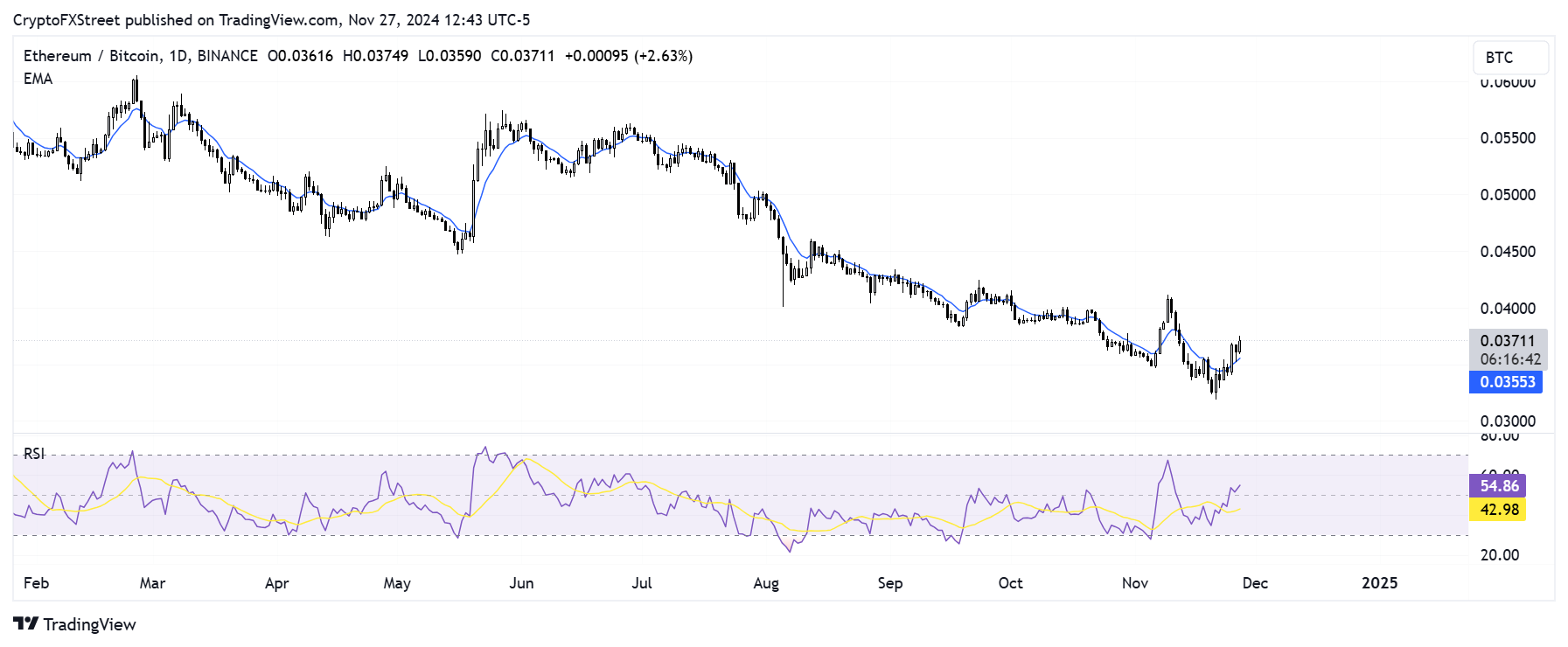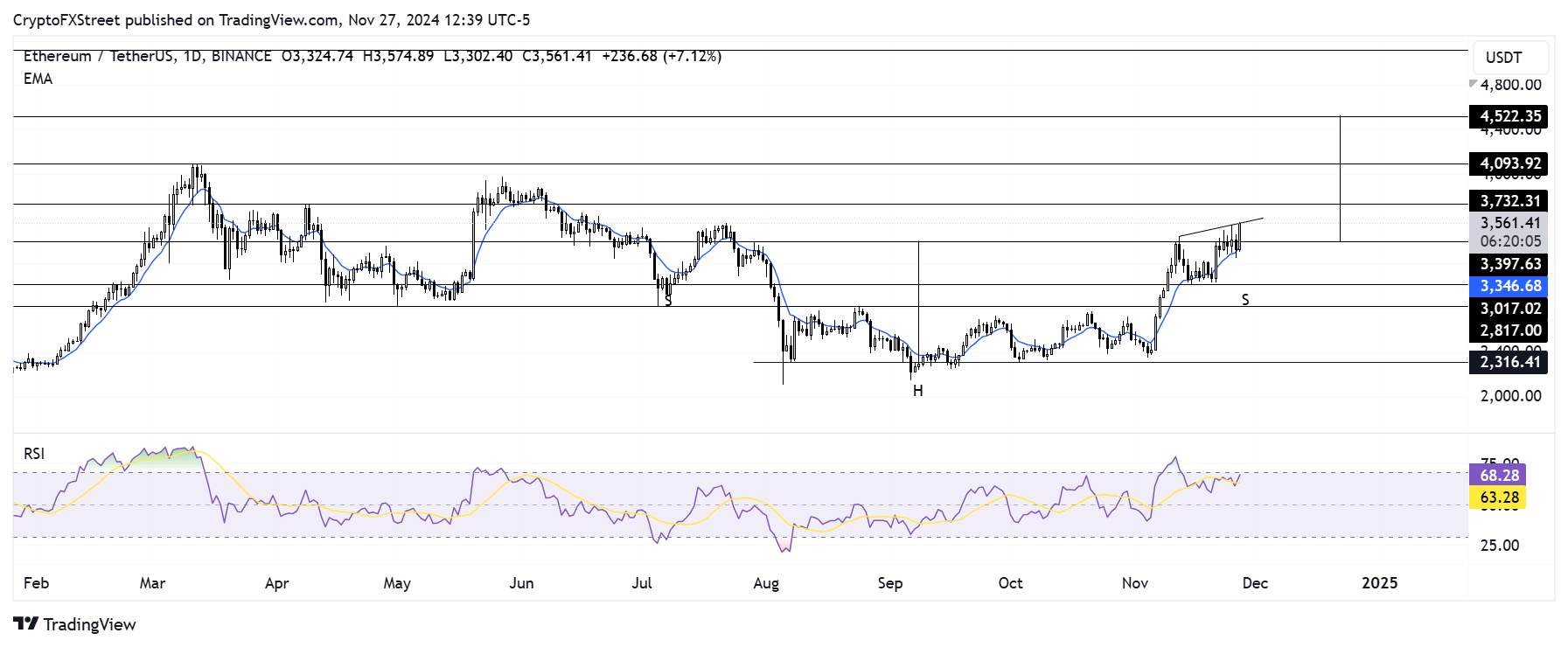Ethereum Price Forecast: ETH surges 9% with increased capital inflows, bulls set sights on $4,522
- Ethereum is seeing high capital inflows amid a 15% ETH/BTC ratio growth.
- ETH's open interest and futures premium show high bullish sentiment among traders.
- Ethereum could rally to $4,522 if it sees a surge above a key ascending trendline resistance.
Ethereum (ETH) rallied 9% on Wednesday following increased capital inflows into ETH ETFs and a major uptick in its open interest and futures premium. If the bullish momentum sustains, ETH could overcome its yearly high resistance of $4,093 and rally to $4,522.
Ethereum witnesses high bullish sentiment amid major ETH/BTC transition
Ethereum ETFs recorded net inflows of $40.6 million on Tuesday, marking a third consecutive day of positive flows for the products, per Coinglass data. This comes amid back-to-back net outflows in Bitcoin ETFs.
Unlike previous times where outflows in BTC ETFs drag ETH alongside it, ETH ETFs are beginning to craft their own path.
A potential reason for the positive flows could be investors rotating from Bitcoin into ETH in anticipation of an altcoin season.
Altcoin season is a phase in the cryptocurrency market cycle where investors take profits after benefiting from the Bitcoin bull market and shift their investments into altcoins with Ethereum as the leading alternative.
Most investors are calling an alt season as Ethereum has been outperforming Bitcoin in the past few weeks. Since reaching a low of $0.3204 on November 21, the ETH/BTC ratio — which measures the performance of ETH compared to BTC — has surged over 15%.

ETH/BTC daily chart
ETH's rise is accompanied by strong bullish sentiment across its derivatives market.
ETH open interest (OI) reached a new all-time high of 6.55 million ETH worth $23.34 billion on Wednesday, continuing its increased growth in the past two weeks, per Coinglass data.
Open interest is the total number of outstanding contracts in a derivatives market. A growth in OI alongside prices signals rising bullish pressure.

ETH Open Interest | Coinglass
Additionally, ETH's three-month premium — the gap between its futures and spot prices — across crypto exchanges Binance, OKX and Deribit surged to 16%, per Velo data.
Ethereum Price Forecast: ETH could complete move to $4,522 with a surge above an ascending trendline resistance
Ethereum is up 9% after sustaining $58.26 million in liquidations in the past 24 hours, per Coinglass data. Liquidated long and short positions accounted for $28.52 million and $29.75 million, respectively.
The top altcoin has surged above the $3,400 key level and is testing an ascending trendline resistance extending from November 12.

ETH/USDT daily chart
If ETH maintains the bullish momentum and overcomes this trendline resistance, it could rally above its yearly high of $4,093 to $4,522. This move will complete the inverted Head-and-Shoulders rally that ETH has been hinting at in the past two weeks.
The Relative Strength Index (RSI) is trending upward and testing the overbought region line, indicating rising bullish momentum.
A daily candlestick close below the $2,817 level will invalidate the bullish thesis and send ETH to find support near $2,300.
Ethereum FAQs
Ethereum is a decentralized open-source blockchain with smart contracts functionality. Its native currency Ether (ETH), is the second-largest cryptocurrency and number one altcoin by market capitalization. The Ethereum network is tailored for building crypto solutions like decentralized finance (DeFi), GameFi, non-fungible tokens (NFTs), decentralized autonomous organizations (DAOs), etc.
Ethereum is a public decentralized blockchain technology, where developers can build and deploy applications that function without the need for a central authority. To make this easier, the network leverages the Solidity programming language and Ethereum virtual machine which helps developers create and launch applications with smart contract functionality.
Smart contracts are publicly verifiable codes that automates agreements between two or more parties. Basically, these codes self-execute encoded actions when predetermined conditions are met.
Staking is a process of earning yield on your idle crypto assets by locking them in a crypto protocol for a specified duration as a means of contributing to its security. Ethereum transitioned from a Proof-of-Work (PoW) to a Proof-of-Stake (PoS) consensus mechanism on September 15, 2022, in an event christened “The Merge.” The Merge was a key part of Ethereum's roadmap to achieve high-level scalability, decentralization and security while remaining sustainable. Unlike PoW, which requires the use of expensive hardware, PoS reduces the barrier of entry for validators by leveraging the use of crypto tokens as the core foundation of its consensus process.
Gas is the unit for measuring transaction fees that users pay for conducting transactions on Ethereum. During periods of network congestion, gas can be extremely high, causing validators to prioritize transactions based on their fees.

